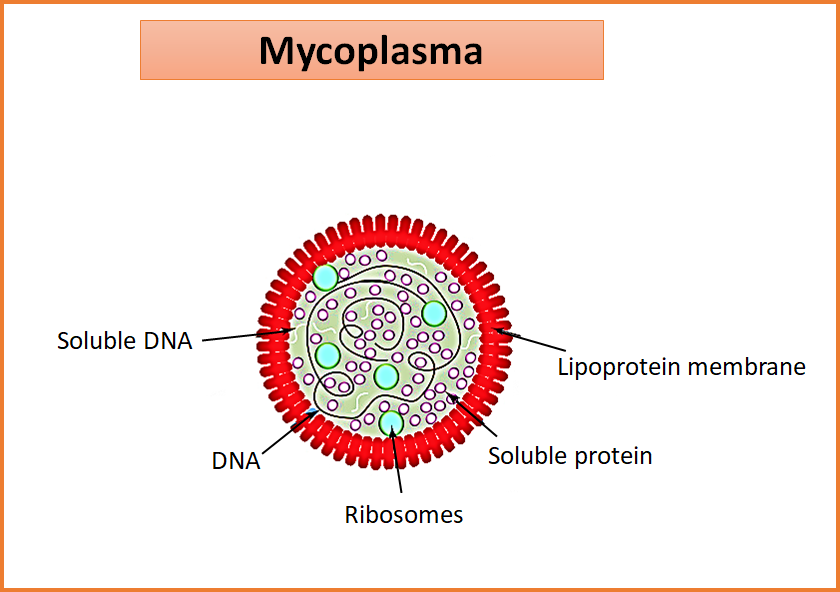
PPLO is the smallest cell.
(a)True
(b)False
Answer
473.4k+ views
Hint: Mycoplasma is the smallest free-living organism. They are pleomorphic and may present as small spherical shapes to long branching filaments.
Complete answer:
Mycoplasma was earlier known as the PPLO or Pleuropneumonia like organisms. They represent the fungus-like form of branching filaments. The size of PPLO ranges from 0.1-0.3 micrometers. Thus, it is the smallest living cell. The general characteristics of PPLO are-
-They are devoid of a rigid cell wall which makes it highly pleomorphic. They possess a triple-layered cell membrane which is rich in cholesterol and other lipids.
-They are so small that they even pass through bacterial filters.
-They are generally parasitic or saprophytic.
-Due to the absence of a cell wall, they are resistant against certain antibiotics like penicillin.
-They can be inhibited by antiseptic solutions like cetrimide and chlorhexidine.
-They have been observed to cause atypical pneumonia, urethritis, pelvic inflammatory disease, etc.
-They differ from viruses in containing both RNA and DNA and can reproduce in cell-free media.
-They generally reproduce by binary fission or budding.
So, the correct answer is ‘True’.
Note: Mycoplasma was first isolated from bovine pleuropneumonia by Nocard and Roux in 1898. They are Gram-negative organisms but generally stained by the Giemsa stain. It is the smallest living cell while viruses are the smallest structures present on this earth. All mycoplasma except Acholeplasma, require sterols for their growth.

Complete answer:
Mycoplasma was earlier known as the PPLO or Pleuropneumonia like organisms. They represent the fungus-like form of branching filaments. The size of PPLO ranges from 0.1-0.3 micrometers. Thus, it is the smallest living cell. The general characteristics of PPLO are-
-They are devoid of a rigid cell wall which makes it highly pleomorphic. They possess a triple-layered cell membrane which is rich in cholesterol and other lipids.
-They are so small that they even pass through bacterial filters.
-They are generally parasitic or saprophytic.
-Due to the absence of a cell wall, they are resistant against certain antibiotics like penicillin.
-They can be inhibited by antiseptic solutions like cetrimide and chlorhexidine.
-They have been observed to cause atypical pneumonia, urethritis, pelvic inflammatory disease, etc.
-They differ from viruses in containing both RNA and DNA and can reproduce in cell-free media.
-They generally reproduce by binary fission or budding.
So, the correct answer is ‘True’.
Note: Mycoplasma was first isolated from bovine pleuropneumonia by Nocard and Roux in 1898. They are Gram-negative organisms but generally stained by the Giemsa stain. It is the smallest living cell while viruses are the smallest structures present on this earth. All mycoplasma except Acholeplasma, require sterols for their growth.

Recently Updated Pages
Master Class 11 Accountancy: Engaging Questions & Answers for Success

Glucose when reduced with HI and red Phosphorus gives class 11 chemistry CBSE

The highest possible oxidation states of Uranium and class 11 chemistry CBSE

Find the value of x if the mode of the following data class 11 maths CBSE

Which of the following can be used in the Friedel Crafts class 11 chemistry CBSE

A sphere of mass 40 kg is attracted by a second sphere class 11 physics CBSE

Trending doubts
10 examples of friction in our daily life

Difference Between Prokaryotic Cells and Eukaryotic Cells

State and prove Bernoullis theorem class 11 physics CBSE

What organs are located on the left side of your body class 11 biology CBSE

Define least count of vernier callipers How do you class 11 physics CBSE

The combining capacity of an element is known as i class 11 chemistry CBSE




